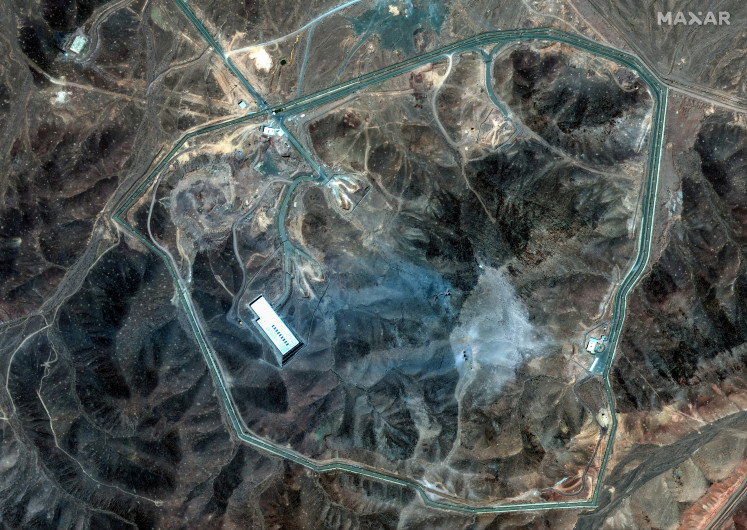Popular Reads
Top Results
Can't find what you're looking for?
View all search resultsPopular Reads
Top Results
Can't find what you're looking for?
View all search resultsExperts raise concerns on use of incinerator in waste facility
Experts have expressed their concerns over the Jakarta administrationâs plan to continue the halted Intermediate Waste Treatment Facilities (ITF) project in Sunter, North Jakarta, as it will include the use of an incinerator to treat the cityâs garbage
Change text size
Gift Premium Articles
to Anyone

E
xperts have expressed their concerns over the Jakarta administration's plan to continue the halted Intermediate Waste Treatment Facilities (ITF) project in Sunter, North Jakarta, as it will include the use of an incinerator to treat the city's garbage.
University of Indonesia environmental engineering expert Gabriel Andari Kristanto said that 60 percent of garbage in Jakarta was organic. 'If the city administration wants to decrease the volume, how many burners will the incinerator need to burn the trash?' she said, adding that the garbage was also wet.
Gabriel also warned that if the garbage was not disaggregated well, the city should pay extra attention to the exhaust gas. 'We need to ensure there is a device to control the exhaust gas,' she said.
According to her, 17 percent of Jakarta's garbage consists of plastic. 'It needs to be burned at a minimum 1,000 degrees Celsius so as to not produce hazardous substances,' she said, adding that the hazardous substances included dioxin and furan.
The expert also questioned whether an incinerator was economically prudent for the city budget. 'We need fuel to burn the garbage. Is it economically wise to do so?' she said.
The same sentiment was delivered by Margaretha Quina, a researcher with the Indonesian Center for Environmental Law (ICEL), who said that the characteristics of waste in Jakarta were not suitable for incinerators using thermal methods to treat garbage.
'Our garbage is too moist. The garbage needs to burn perfectly to create energy,' she said.
Margaretha said that Indonesia also had the National Appropriate Mitigation Action (Namas), a set of policies and actions the country was required to undertake as part of its commitment to reduce greenhouse gas emissions.
'Namas' recommends waste treatment focusing on sanitary landfills, treatment at the source of garbage, recycling and a waste-to-energy project using non-thermal technology such as gasification.
The researcher also delivered her concerns over the level of dioxin in Indonesia, which is seven times higher than that in the US.
'The level was measured in 2014 when forest fires had not started and the ITF had not been built,' she said.
The city administration aims to reduce its dependence on the Bantar Gebang landfill in Bekasi to handle the city's 6,700 tons of daily garbage.
The ITF project in Sunter was initiated by former governor Fauzi Bowo. However, the execution was tardy due to bureaucracy and tender-related issues.
Jakarta Sanitation Agency head Isnawa Adji said previously that the winner of the tender would be announced soon and that the groundbreaking was expected to be held in February or March.
Twelve environmental organizations jointly declared in December that a waste treatment plant using thermal technology or an incinerator was a waste of energy and a reckless way to treat garbage. The declaration was made in response to a statement by President Joko 'Jokowi' Widodo on easing permit issuance procedures for waste to energy (W2E) investors.
Dedy Setiono of the sanitation agency, a bidding committee member of the ITF project, said that the decision to use an incinerator was based on a study conducted a year prior to the initiation of the project in 2011.
Dedy said an incinerator was considered the most suitable technology for the ITF in Sunter, where the land on which is sits measures 4.5 hectares.
'The technology was also not expensive. It was around Rp 1.3 trillion [US$93.6 million] in 2011,' he said.
Dedy said as the tender was ongoing, it would be impossible to change the technology of the garbage treatment plant.
'The concept is waste to energy. It will produce up to 14 Megawatts with a capacity of 1,000 tons,' he said.
Regarding the unsafe residue, Dedy said the city administration would ensure that the garbage burned at up to 1,000 degrees Celsius. 'The contractor will be also obliged to install a gas exhaust control device,' he said, adding that the gas released to open air would be safe.









